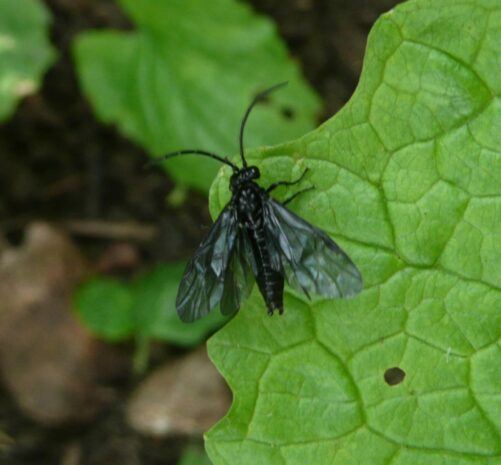Solomon’s seal sawfly resembles a caterpillar when it is in its larvae stage. They are greyish white in colour and are about 2 cm long. They are distinguishable from a caterpillar because of their blackhead. They also resemble a flying ant when they are in their adult stage. During an adult stage sawflies are black in colour, 8-9 mm long, bearing wings which help them in flying. They are known to destroy the many plants like Solomon’s seals and many plants belonging to the Polygonatum genus.
What is Solomon’s seal sawfly?
Sawflies belong to the group of insects, just like bees and ants. The off-springs of Solomon’s seal sawfly in the larvae stage resemble the larvae of the caterpillar, and these larvae feed on the leaves of the Polygonatum. The adult Solomon’s seal fly is fly-like and also bears wings.
Solomon’s seal sawfly Facts
Some quick facts about Solomon’s seal sawfly are;
- Its common name is Solomon’s Seal Sawfly.
- Its Latin name is Phymatocera aterrima.
- Solomon’s seal sawfly affects different plants; some of them are Solomon’s seal, Polygonatum species and its hybrids.
- They are greyish-white in colour, and their larvae resemble a caterpillar bearing a black head.
- They are about 2 cm long and can be seen on the underside of leaves eating elongated strips of foliage.
- The larvae of Solomon’s seal sawfly feed in groups and defoliation can occur very quickly.
- The early symptom of Solomon’s seal sawfly during late spring is, they can be the victims of complete defoliation.
- They leave purplish-brown scars on the leaves, about ¾ inches long, where eggs were inserted.
- Adults are dark-coloured flying insects, 8-9 mm long, which are often mistaken for flying ants.
- Adult females have a sawtooth ovipositor, which is used to cut open the soft tissues of plants and lay eggs in them.
- The larvae very quickly deprive the plant of leaves. Adults are not a problem as they feed on pollen. The affected plants may survive, but they will not flourish.
- They are found during the summer season on plants like Solomon’s seal and other plants of the Polygonatum genus.
Solomon’s seal sawfly Life cycle
Sawfly females lay eggs on leaf stalks in May / June, during the late spring season, and their larvae hatch after a week. The larvae then feed on the plant for a month before entering the soil. After a month of being in the larvae stage, they then transform into a pupa to overwinter before growing into adults in May / June. The Solomon’s seal sawfly reproduces and generates offspring only once a year.
Solomon’s seal sawfly Traps
Although defoliation caused by Solomon’s seal fly may appear severe, it usually occurs after flowering and plants generally thrive in the year following an attack. Therefore this insect can be tolerated, and the plants will survive.
Check sensitive plants frequently from late May onwards, so that you can take action before a harmful infestation develops. When choosing control options, harm to non-target animals can be minimised by starting with the methods in the section on non-pesticide control. If that’s not enough to reduce the damage to acceptable levels, you can choose to use pesticides. Within this group, less persistent pesticides (which are usually certified for organic cultivation) are likely to be less harmful to non-target wildlife than those with longer persistence and systemic action.
Solomon’s seal sawfly Treatment
Solomon’s seal sawfly can be treated in two ways, either with pesticides or without pesticides.
Treatment without Pesticides
Solomon’s seal sawfly can be treated without pesticides in the following ways.
- Treatment of Solomon’s seal sawfly can be done by preventing further reproduction of sawflies and making their population tolerable.
- The population of sawflies can be further reduced by encouraging predators and natural enemies, like birds etc.
- Try to look for larvae of Solomon’s seal sawfly after May, and remove them by hand.
Treatment with Pesticides
When controlling Solomon’s seal sawfly is challenging to be handled without pesticides, then it is necessary to opt for pesticides.
- For a large number of larvae, the manual collection is not easy; it can be controlled by spraying with pesticides. Spraying at dusk gives the best results.
- Use insecticides with organic contact containing natural pyrethrins (e.g. Bug Clear Gun for Fruit & Veg and Larvae Killer). These products have short staying power so it is advised to perform several applications for adequate control.
- Products with more persistence/ staying power are synthetic pyrethroids lambda-cyhalothrin, deltamethrin, and cypermethrin, etc.



